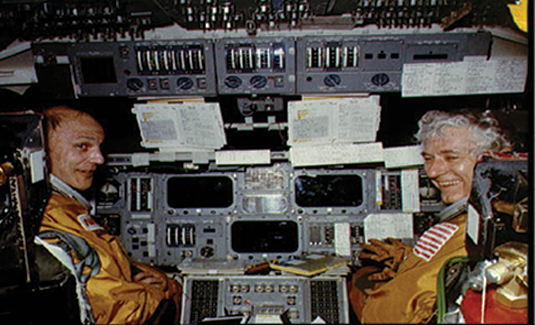 [Continued]
[Continued]
Woltosz and Abercrombie developed the space shuttle’s rollover maneuver in 1971 by using computer software they created called the rocket ascent G-limited moment-balanced optimization program, or RAGMOP, to optimize the vehicle’s pitch and yaw.
Champion, who began his NASA career as a propulsion engineer in the preliminary design office at Marshall Space Center, earned NASA’s Medal for Exceptional Achievement for technical leadership in space shuttle propulsion systems. Smith also spent much of his career designing and developing propulsion systems at Marshall, but his biggest challenge came when he was tapped to lead the efforts to design, build, qualify and fly the shuttle’s redesigned solid-rocket motor following the Challenger accident.
The United States lost seven astronauts that day in 1986, and the world watched in horror as the space shuttle broke apart high above the Atlantic Ocean. Before Challenger, most Americans had never heard of an “O-ring,” nor could they tell you how a solid rocket booster propelled the shuttle into space. In the weeks following the accident, the entire country would learn how the failure of those components could change the course of American history. The tragedy would also serve as a harsh reminder of the risks associated with space flight that so many Americans had put to bed following the lunar landing and unprecedented success of Apollo missions.
The space shuttle was a complex vehicle, and not perfect — no machine is. It could be independently maneuvered in and out of orbit, acting as a glider for re-entry with support from an orbital maneuvering system. The orbiter launched vertically, carrying four to eight astronauts and up to 50,000 pounds of cargo, and is the only winged, manned spacecraft that has been placed in orbit, as well as the only reusable space vehicle to make multiple space flights. It’s hard to imagine that the man who first envisioned such a spacecraft may have done so as early as the 1950s, and that much of its continued success was directed by Auburn engineers.
Wayne Owens, ’64 mechanical engineering, worked at the shuttle’s payloads directorate on processing payloads for launch and then with cargo integration and operations at Johnson Space Center, where he was responsible for all shuttle payload activities.
Carver Kennedy, a ’52 graduate in mechanical engineering, was responsible for the development and production of solid rocket motors for industry and NASA’s shuttle. After Challenger, he served on the Kennedy Space Center Accident Investigation Board and the Rogers Commission, charged with investigating the accident. He testified at the Congressional Committee hearings before he returned home to help with the redesign, one of nine commission recommendations to improve safety.
When Discovery lifted off in September 1988, the launch represented a test of the redesigned boosters, as well as a shift to a more conservative position on safety. Following the success of that mission, NASA continued a regular schedule of STS flights that would continue, generally uninterrupted, for 15 years. Smith and Kennedy, along with a number of other Auburn engineers, supported a redesign project for the solid-rocket motor that helped to restore confidence in the nation’s space program.
In the ‘80s and ‘90s, astronauts Jan Davis, a ‘77 graduate in mechanical engineering, and Jim Voss, a ‘72 graduate in aerospace engineering, flew shuttle missions, logging hundreds of hours in space. Voss, who helped build the international space station, even carried a few Auburn items into zero gravity — some Auburn t-shirts and a flag — on one of his five missions and four spacewalks. Before she flew missions, Davis was the lead engineer for the redesign of the shuttle’s solid rocket booster external tank attach ring.
Jim Kennedy, a ’72 graduate in mechanical engineering, left the aerospace industry to work in the project control office for space shuttle projects when he could no longer ignore his passion for spaceflight. He is of no relation to Carver Kennedy; they simply have Auburn and the space shuttle in common.
Kennedy was made a manager of the shuttle program planning and management systems office. He played major roles in projects that included the concept flight vehicle Delta Clipper Experimental, DC-XA and X-34. In 1996, he became program manager of the space shuttle solid rocket booster project office.
